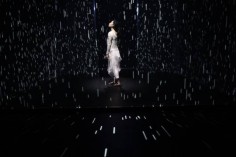ADRIEN M / CLAIRE B
Hakanaï
source: am-cbnet
Hakanaï est une performance chorégraphique pour une danseuse évoluant dans un volume d’images en mouvement. Dans la langue japonaise, Hakanaï définit ce qui est impermanent, fragile, évanescent, transitoire, entre le rêve et la réalité. Mot très ancien, il évoque une matière insaisissable associée à la condition humaine et à sa précarité, mais associée aussi à la nature. Il s’écrit en conjuguant deux éléments, celui qui désigne l’homme et celui qui désigne le songe. Ce collage symbolique est le point de départ de cette partition pour une danseuse rencontrant des images, faisant naître un espace situé à la frange de l’imaginaire et du réel. Les images sont animées en direct, selon des modèles physiques de mouvement, au rythme d’une création sonore également interprétée en direct. À l’issue du temps de performance, l’installation numérique est ouverte aux spectateurs.
L’élaboration de cette pièce qui a débuté en juin 2012 se nourrit de restitutions publiques jusqu’en novembre 2013, date de sa création.
.
.
.
.
.
.
.
source: vimeo
La compagnie Adrien M / Claire B travaille dans le champ des arts numériques et des arts vivants depuis 2004. Elle crée des formes allant du spectacle aux expositions associant le réel et le virtuel, avec comme spécificité le développement sur-mesure de ses propres outils informatiques. Elle met l’humain et le corps au centre des enjeux technologiques et artistiques, utilisant les outils d’aujourd’hui au service d’une poésie atemporelle, construisant et utilisant un langage visuel basé sur le jeu et le plaisir comme support d’imaginaire. Son projet est porté par Adrien Mondot et Claire Bardainne. La compagnie est installée sur la Presqu’île de Lyon où elle occupe un atelier de recherche et de création.
La compagnie est installée sur la Presqu’île de Lyon où elle occupe un atelier de recherche et de création.
Elle est conventionnée par la DRAC Rhône-Alpes, par la Région Rhône-Alpes et soutenue par la ville de Lyon.
.
.
.
.
.
.
source: vimeo
Hakanaï is a haiku dance performance taking place in a cube of moving images projected live by a digital performer.
In Japanese, this word Hakanaï is the union of two elements, one alluding to man and one alluding to the dream. It is used to define the ephemeral, the fragile, the transitory, the intangible nature of matter.
This words together with the tulle covered cube, create the starting point for this piece.
The four projectors reveal on the tulle a graphic universe in constant evolution. Performed by an artist as a “digital score”, it is generated and interpreted live. The dancer’s body enters into a dialogue with the moving images in motion. These simple and abstract black and white shapes behave according to physical rules that the senses recognise and to mathematic models created from the observation of nature.
The audience experiences the performance in several stages. They first discover the exterior of the installation. As the dancer arrives, they gather around to watch the performance. When the choreography has ended, the audience can then take some time to wander amongst the moving images.
Through a minimalist transposition, this piece is based on images drawn from the imaginary realm of dreams, their structure and their substance. The box in turns represents: the bedroom where, once the barrier of sleep is passed, walls dissolve and a whole new inner space unfolds; the cage, of which one must relentlessly test the limits; the radical otherness, as a place of combat with an intangible enemy; the space where impossible has become possible, where all the physical points of reference and certitudes have been shaken.
Through the encounter of gesture and image, two worlds intertwine. The synchronicity between the real and the virtual dissolves and the boundary that was keeping them separate disappears, forming a unique space filled with a high oneiric charge.
Our research is mainly based around the following:
1. A thoughtful digital technology at the service of performing arts.
In order to preserve the force of the live presence on stage and then transpose it to the digital medium, all the images are generated, calculated and projected in real time.
2. The idea of digital writing and performance of digital scores.
Through a musical approach to the images and an instrumental approach to the computer program, the experience of the moment is given pride of place.
3. Interactive ways of overcoming the technical challenge.
Using capturing systems from video game technology (for their power in calculation and reactivity) combined to a work of virtual puppetry (for the value of human intuition and its dreaming ability) allow us to offer the audience this sensitive experience.
4. The use of the unconscious experience of movement.
The computing and mathematical models come from the observation of Nature. This private and unconscious experience of movement creates an imaginary world where abstract graphic forms become evocative worlds.
5. The structuration of coincidences.
The gesture interferes with the image in a believable and coherent way. Creating strong bridges between the digital and the real material allows the virtual to become an extension of the real.
Concretely, the implementation of these principles is the result of a close relationship between computers, electronics and software all through the computer program eMotion. eMotion is a tool allowing the experimentation of the relationships between virtual elements and data taken from the real world. It is based on physics models and is at the heart of and at the beginning of all of the company’s projects. Although the project is the result of research into juggling, it goes way beyond its original subject while at the same time inheriting the concrete and sensitive relationship to matter, body and movement.


